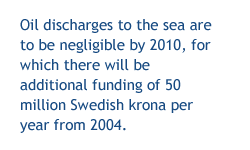|
Posted
6th May 2001
(Photo Swedish Environment Minister Kjell Larsson)
The
Swedish government today underlined its determination to make
Sweden the world's most environmentally sustainable nation by
proposing a series of legal targets and deadlines for implementing
15 over-arching environmental quality objectives adopted in
1999. Designed to achieve environmental sustainability within
one generation, the new environmental quality objectives bill
sets out about 60 "concrete measures and strategies" to achieve
14 of the 15 quality objectives by 2010. Separate proposals
on how to achieve "reduced climate impact" will emerge this
autumn.
The
law is largely based on proposals from a government committee
last June. The move has even greater impact because Sweden now
holds the revolving six months Presidency of the European Union.
 Environment
Minister Kjell Larsson showed clear pride in the achievement
today. "Never before has such a well prepared and well supported
proposal been presented in the field of environmental protection,"
he stated. The government was creating a "unique and ultra-modern
environmental policy mechanism," he said. Government funding
for environmental protection is to rise by 70 percent by 2004. Environment
Minister Kjell Larsson showed clear pride in the achievement
today. "Never before has such a well prepared and well supported
proposal been presented in the field of environmental protection,"
he stated. The government was creating a "unique and ultra-modern
environmental policy mechanism," he said. Government funding
for environmental protection is to rise by 70 percent by 2004.
Last month the finance ministry pledged only a 25 percent rise
in green spending by then. Several elements in the draft law
go further than existing policies. To achieve the objective
of clean air, for example, the government pledges to reduce
sulphur dioxide emissions by "at least" 7,000 tonnes per year
more than required under either the UN Gothenburg Protocol or
the draft European Union national emission ceilings directive.
Emissions of nitrogen oxides and volatile organic compounds
are to be cut by 44 percent by 2010 compared with today. The
government says it is "raising the stakes" on forest protection
by providing long term protection for a further 900,000 hectares
(3,474 square miles). An existing national plan for protecting
wetlands is to be implemented in its entirety by 2010, which
means safeguards for a further 300 sites. To achieve "zero eutrophication,"
nitrogen discharges to the Baltic Sea are to be cut by at least
30 percent by 2010. From next year the government is to pay
an extra 1.6 million euros to reduce lake and river acidity.
Furthermore, half of the entire water environment should be
placed under long term protection by 2010.
Oil discharges to the sea are to be negligible by 2010, for
which there will be additional funding of 50 million Swedish
krona per year from 2004. Back on land, at least 50 of the 100
highest priority contaminated sites are to be completely remediated
by 2005. The current planning and building act is to be reviewed
based on strategies aimed at cutting car use and making energy
consumption more efficient. Monitoring progress under the law
is to be the responsibility of a new environmental quality objectives
council, using a new system of environmental indicators. The
government will report to parliament annually, with "a fundamental
review" every four years.

|